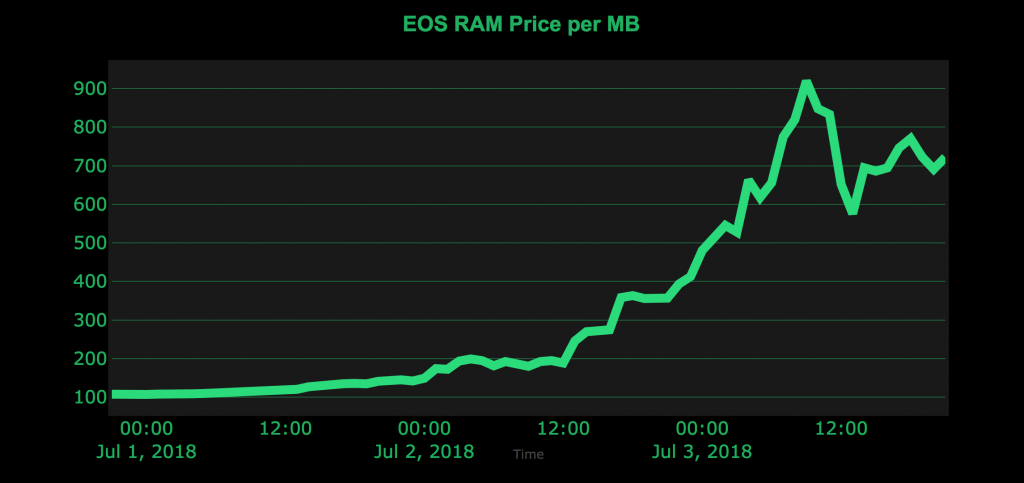Hoarders Drive EOS RAM Market Prices Beyond Affordability
Photo by Nathan Riley on Unsplash
Little-known to the average investor, data markets hold tremendous value for both developers and traders. The EOS RAM market – selling memory space to developers – is seeing a spike in price per megabyte due to centralized ownership.
Intro to the EOS RAM Market
In order to distribute RAM across the EOS network, the EOSIO Dawn 4.0 mainnet uses an updated market-based allocation approach allowing token holders to buy and sell database space at prevailing market prices.
Decentralized applications require a significant amount of memory space to store temporary data for their programs, which developers can purchase with EOS on the EOS RAM market.
Although an innovative solution to RAM distribution, the market-based approach leaves the allocation of RAM susceptible to shortages and price inflation.
In the blog post announcing EOSIO Dawn 4.0, CTO Daniel Larimer wrote:
“Under the Dawn 3.0 system contract, you could only sell RAM for the price you paid. The goal was to disincentivize hoarding and speculation.
As stated, the previous version of the RAM market used a fixed price mechanism to prevent hoarding and speculation in the marketplace. Alternatively, the updated RAM market lets trades fluctuate the value of RAM on the network.
“Under Dawn 4.0 the system contract now buys and sells RAM allocations at prevailing market prices. This may result in traders buying RAM today in anticipation of potential shortages tomorrow.”
Whales Corner the Market
It’s becoming evident the new market-based approach enables speculators to profit from hoarding RAM – removing the incentive to leave database space available for developer use and causing the price per MB to rise rapidly.
An EOS community member, @ferdousbhai, took to Twitter to share the increasing scarcity of RAM on the EOS network:
When buying RAM, you are trading against Bancor algo. The algo is fed $EOS from all people that bought RAM before you.
The algo doesn’t care how high the price is and will pay literally anything until people start giving back the RAM.
At 99% utilization, 1KB RAM costs 147 EOS. pic.twitter.com/atv2mdGyDj
— Ferdous ฿hai (@ferdousbhai) July 3, 2018
With over 85% of available RAM being kept by select individuals, the demand for the scarce developer resource is driving prices beyond affordability. At the current rate, the cost of 1 MB of RAM is approximately 715 EOS (~$6455 USD).
Given that there are no applications currently running on the EOS platform, it makes little sense why 85% of the available RAM has already been claimed for use. The reason? Speculators are hoarding RAM in anticipation of rising demand and price.

As a solution to RAM hoarding, the EOS community has proposed block producers confiscate utilized RAM from hoarders who intend to profit rather than allocate data space for developer use. Alternatively, the EOS network could increase the available capacity of RAM on the platform.
An EOS blog post mentions that through Moore’s Law – a prediction that computation power will double every two years – the network’s supply of RAM will eventually increase to 4TB.
“Over time Moore’s law will allow block producers to upgrade to 4TB or even 16TB of RAM and this increase in supply will trickle into the the EOSIO RAM market lowering prices.”
However, this upgrade to RAM capacity requires a two-thirds or greater vote by the 21 block producers governing the EOS network – leaving the future of the RAM market in the hands of a centralized body who may or may not own RAM themselves.
RAM traders and speculators hoarding their RAM holdings in a market shortage have little incentive to free up memory space for developer use, creating an unanticipated obstruction to DApp development on the EOS platform and a price per MB that will continue to rise towards infinity.
As stated in the EOS blog post announcing EOSIO Dawn 4.0:
“As RAM is reserved the price will automatically increase so that the price approaches infinity before the system runs out of RAM.”
Unless resolved, the development of dApps on the EOS network may soon become too expensive. What the EOS community and block producers decide as a solution to the RAM market shortage has yet to be uncovered.
























































































